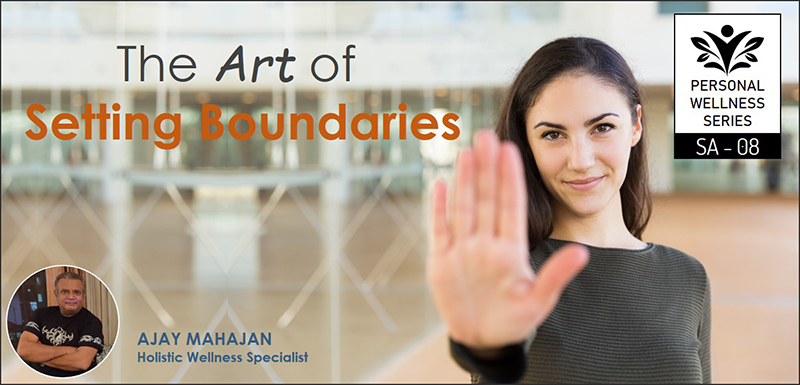
In the complex dance of life, setting boundaries is a graceful and essential art. It involves defining the limits that safeguard your mental and emotional well-being, allowing you to navigate relationships, work, and personal life with intention and balance. This article will explore the nuances of the art of setting boundaries, a critical aspect of personal wellbeing, shedding light on why it’s crucial for mental health, and offer practical insights into how to establish and maintain healthy boundaries in various aspects of life.
Understanding Boundaries
· Defining Personal Boundaries
Boundaries are the invisible lines that delineate the emotional, physical, and mental limits you establish for yourself. They serve as the framework for healthy relationships and self-care, preventing burnout and fostering personal growth.
· Types of Boundaries
- Physical Boundaries: Protecting your personal space and body
- Emotional Boundaries: Safeguarding your emotions and not taking on others’ emotional burdens
- Time Boundaries: Allocating time for yourself and setting limits on commitments
- Material Boundaries: Establishing rules around personal possessions and resources
The Importance of Setting Boundaries for Mental Health
· Preventing Burnout
Boundaries act as a shield against burnout, especially in demanding work environments or relationships. They prevent the depletion of emotional and mental resources, ensuring a sustainable balance.
· Preserving Emotional Well-being
By setting emotional boundaries, you protect yourself from absorbing the emotional struggles of others. This is crucial for maintaining emotional stability and preventing compassion fatigue.
· Promoting Healthy Relationships
Boundaries are the cornerstone of healthy relationships. They communicate your needs and expectations, fostering understanding and respect between individuals.
· Enhancing Self-Esteem
Setting and enforcing boundaries is an affirmation of self-worth. It communicates to yourself and others that your needs are valid and deserving of respect.
Practical Strategies for Setting Boundaries
· 1. Self-Reflection: Know Your Limits
Identify Your Values: Understanding your core values helps you set boundaries aligned with your principles.
Recognize Emotional Triggers: Be aware of situations or behaviours that trigger discomfort, helping you set boundaries where needed.
· 2. Effective Communication
Be Direct and Clear: Clearly communicate your boundaries without ambiguity.
Use “I” Statements: Express your needs using “I” statements to convey your feelings without sounding accusatory.
· 3. Learn to Say No
Prioritize Self-Care: Saying no is not a rejection; it’s a prioritization of your well-being.
Set Limits on Commitments: Evaluate your capacity before committing to additional responsibilities.
· 4. Establish Work-Life Balance
Define Work Hours: Clearly delineate your work hours and resist the urge to consistently work beyond them.
Take Breaks: Incorporate breaks into your workday to recharge and prevent burnout.
· 5. Technology and Social Media Boundaries
Designate Tech-Free Zones: Create spaces and times where technology is intentionally put aside.
Manage Social Media Use: Set limits on the time spent on social media to protect your mental space.
· 6. Set Relationship Boundaries
Clarify Expectations: Clearly communicate your expectations in relationships, whether with family, friends, or romantic partners.
Establish Emotional Boundaries: Clearly express when certain topics or behaviors are emotionally taxing.
· 7. Learn to Delegate
Trust Others: Delegate tasks when possible, trusting others to contribute and share responsibilities.
Recognize Your Capacity: Be realistic about what you can handle and ask for help when needed.
· 8. Practice Assertiveness
Use “I” Statements: Express your needs assertively using “I” statements.
Stand Firm: Be firm but respectful in maintaining your boundaries, even if others may not initially understand.
· 9. Seek Professional Guidance
Therapy and Counseling: A mental health professional can provide guidance on boundary setting, especially if past experiences have made this challenging.
Group Support: Joining support groups can provide insights and encouragement from others navigating similar boundary-setting journeys.
Challenges in Setting Boundaries and How to Overcome Them
· Fear of Rejection or Conflict
Shift Focus: Instead of fearing conflict, focus on the long-term benefits of healthy boundaries.
Practice Responses: Prepare responses for potential pushback, making it easier to assert your boundaries.
· Guilt and People-Pleasing Habits
Cultivate Self-Compassion: Understand that setting boundaries is an act of self-compassion, not selfishness.
Challenge Guilt: Examine the source of guilt and reframe it as a necessary step for your well-being.
· Fear of Disappointing Others
Clarify Intentions: Communicate your boundaries with kindness, emphasizing that it’s about your needs, not a rejection of the other person.
Reframe Disappointment: Understand that disappointment is a natural part of life, and it’s not your sole responsibility to prevent it.
Boundaries in Evolving Relationships
· Reevaluate and Adjust
Check-In Periodically: Relationships evolve, and so should boundaries. Periodically assess your boundaries and adjust them as needed.
Open Communication: Foster open communication with others about changing needs and expectations.
· Consistency is Key
Be Consistent: Consistency in enforcing boundaries is crucial for their effectiveness.
Adapt as Necessary: Adapt your boundaries based on the evolving dynamics of the relationship.
Conclusion
The art of setting boundaries is a continual process of self-discovery, assertiveness, and self-care. It involves understanding your needs, communicating them effectively, and maintaining the courage to uphold them.
By establishing and enforcing healthy boundaries, you empower yourself to lead a life that prioritizes mental and emotional well-being, creating the space for authentic connections and personal growth. Remember, setting boundaries is not a sign of weakness; it’s a testament to your commitment to self-respect and a flourishing life.
Ajay Mahajan | Holistic Wellness Specialist
Founder & CEO – Wellness Seekers Academy
+91 96548 89815 | ajm@ajaymahajan.info
